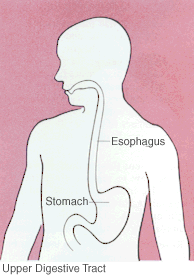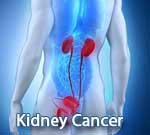Esophageal Cancer
Introduction:
The diagnosis of cancer of the esophagus* brings with it many questions and a need for clear, understandable answers. We hope this page will help. It provides information about the symptoms, diagnosis, and treatment of cancer of the esophagus, and it describes some of the possible causes (risk factors) of this disease. Having this important information may make it easier for patients and their families to handle the challenges they face
The Esophagus
The esophagus is a hollow tube that carries food and liquids from the throat to the stomach. When a person swallows, the muscular walls of the esophagus contract to push food down into the stomach. Glands in the lining of the esophagus produce mucus, which keeps the passageway moist and makes swallowing easier. The esophagus is located just behind the trachea (windpipe). In an adult, the esophagus is about 10 inches long.

Understanding the Cancer Process
Cancer is a disease that affects cells, the body's basic unit of life. To understand any type of cancer, it is helpful to know about normal cells and what happens when they become cancerous.
The body is made up of many types of cells. Normally, cells grow, divide, and produce more cells when they are needed. This process keeps the body healthy and functioning properly. Sometimes, however, cells keep dividing when new cells are not needed. The mass of extra cells forms a growth or tumor. Tumors can be benign or malignant.
- Benign tumors are not cancer. They usually can be removed and, in most cases, they do not come back. Cells in benign tumors do not spread to other parts of the body. Most important, benign tumors are rarely a threat to life.
- Malignant tumors are cancer. Cells in malignant tumors are abnormal and divide without control or order. These cancer cells can invade and destroy the tissue around them. Cancer cells can also break away from a malignant tumor and enter the bloodstream or lymphatic system (the tissues and organs that produce, store, and carry white blood cells that fight infection and other diseases). This process, called metastasis, is how cancer spreads from the original (primary) tumor to form new (secondary) tumors in other parts of the body.
Cancer that begins in the esophagus (also called esophageal cancer) is divided into two major types, squamous cell carcinoma and adenocarcinoma, depending on the type of cells that are malignant. Squamous cell carcinomas arise in squamous cells that line the esophagus. These cancers usually occur in the upper and middle part of the esophagus. Adenocarcinoma usually develops in the glandular tissue in the lower part of the esophagus. The treatment is similar for both types of esophageal cancer.
If the cancer spreads outside the esophagus, it often goes to the lymph nodes first. (Lymph nodes are small, bean-shaped structures that are part of the body's immune system.) Esophageal cancer can also spread to almost any other part of the body, including the liver, lungs, brain, and bones
Risk Factors
The exact causes of cancer of the esophagus are not known. However, studies show that any of the following factors can increase the risk of developing esophageal cancer:
- Age. Esophageal cancer is more likely to occur as people get older; most people who develop esophageal cancer are over age 60.
- Sex. Cancer of the esophagus is more common in men than in women.
- Tobacco Use. Smoking cigarettes or using smokeless tobacco is one of the major risk factors for esophageal cancer.
- Alcohol Use. Chronic and/or heavy use of alcohol is another major risk factor for esophageal cancer. People who use both alcohol and tobacco have an especially high risk of esophageal cancer. Scientists believe that these substances increase each other's harmful effects.
- Barrett's Esophagus. Long-term irritation can increase the risk of esophageal cancer. Tissues at the bottom of the esophagus can become irritated if stomach acid frequently "backs up" into the esophagus -- a problem called gastric reflux. Over time, cells in the irritated part of the esophagus may change and begin to resemble the cells that line the stomach. This condition, known as Barrett esophagus, is a premalignant condition that may develop into adenocarcinoma of the esophagus.
- Other Types of Irritation. Other causes of significant irritation or damage to the lining of the esophagus, such as swallowing lye or other caustic substances, can increase the risk of developing esophageal cancer.
- Medical History. Patients who have had other head and neck cancers have an increased chance of developing a second cancer in the head and neck area, including esophageal cancer.
Having any of these risk factors increases the likelihood that a person will develop esophageal cancer. Still, most people with one or even several of these factors do not get the disease. And most people who do get esophageal cancer have none of the known risk factors.
Identifying factors that increase a person's chances of developing esophageal cancer is the first step toward preventing the disease. We already know that the best ways to prevent this type of cancer are to quit (or never start) smoking cigarettes or using smokeless tobacco and to drink alcohol only in moderation. Researchers continue to study the causes of esophageal cancer and to search for other ways to prevent it. For example, they are exploring the possibility that increasing one's intake of fruits and vegetables, especially raw ones, may reduce the risk of this disease.
Researchers are also studying ways to reduce the risk of esophageal cancer for people with Barrett's esophagus
Recognizing Symptoms
Early esophageal cancer usually does not cause symptoms. However, as the cancer grows, symptoms may include:
- Difficult or painful swallowing
- Severe weight loss
- Pain in the throat or back, behind the breastbone or between the shoulder blades
- Hoarseness or chronic cough
- Vomiting
- Coughing up blood
These symptoms may be caused by esophageal cancer or by other conditions. It is important to check with a doctor





































